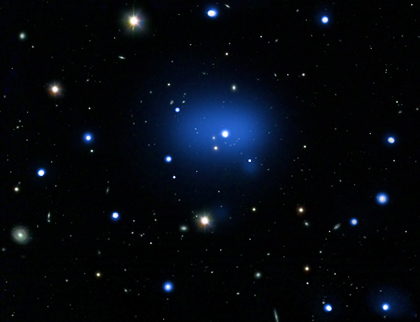Galaxy Cluster Smashes Distance Record
This is a composite image of the most distant galaxy cluster yet detected. This image contains X-rays from NASA's Chandra X-ray Observatory, optical data from the Very Large Telescope (VLT) and optical and infrared data from the Digitized Sky Survey. This record-breaking object, known as JKCS041, is observed as it was when the Universe was just one quarter of its current age. X-rays from Chandra are displayed here as the diffuse blue region, while the individual galaxies in the cluster are seen in white in the VLT's optical data, embedded in the X-ray emission.
Chandra Source Catalog: Onto the Google Sky (Part 1)
From time to time in the Chandra blog, we like to give a look at the behind the scenes of how things really work around here. As you may suspect, it takes a lot of effort from many, many people to make this mission a success. One area we haven't delved into too much yet is the "data analysis" and other herculean efforts that are required to make the Chandra data as useful and user-friendly as possible to the scientific community.
Meet an Astronomer: Carles Badenes
We've spent a lot of time lately talking about the past 10 years. This has been for an excellent reason, of course: the observatory and the scientists that use it have just done so many great things.
But we don't want to spend too much energy looking back, because there are so many exciting things are still very much in front of us. We recently sat down with some of the best and brightest scientists who are using Chandra and will take the science into its next decade of discovery. We'll share some of those conversations with you here. We hope you sense, like we do, that the best may yet to come.
Three Important Letters and The Nobel Prize
Yesterday, the Nobel Prize for Physics was announced by the Royal Swedish Academy of Sciences. As they often do, the Academy split the prize, with one half being shared by two scientists - William S. Boyle and George E. Smith - for their work on CCD sensors.

William S. Boyle (left) and George E. Smith in a shot taken in 1974. © Alcatel-Lucent/Bell Labs
Black Holes Go "Mano A Mano"
This image of NGC 6240 contains new X-ray data from Chandra (shown in red, orange, and yellow) that has been combined with an optical image from the Hubble Space Telescope originally released in 2008. In 2002, the discovery of two merging black holes was announced based on Chandra data in this galaxy. The two black holes are a mere 3,000 light years apart and are seen as the bright point-like sources in the middle of the image.
Beginning Chandra's Next Decade of Discovery

This week, about 200 scientists are gathered in Boston to describe, discuss, and dissect the past ten years of Chandra science. The symposium, dubbed "Chandra's First Decade of Discovery," has some exciting happenings. First, the astronauts from STS-93, the Space Shuttle mission that launched Chandra into orbit back in July 1999, are here. They are going to participate in a session this afternoon on "The History of Chandra." In addition to the astronauts, key scientists responsible for Chandra being the success that it is will be on hand. Tomorrow, Nobel-Prize winner Riccardo Giacconi will address the conference. Dr. Giaconni won the Nobel for physics for his work in the field of X-ray astronomy, including, of course, Chandra.
New Vista of Milky Way Center Unveiled
A dramatic new vista of the center of the Milky Way galaxy from NASA's Chandra X-ray Observatory exposes new levels of the complexity and intrigue in the Galactic center. The mosaic of 88 Chandra pointings represents a freeze-frame of the spectacle of stellar evolution, from bright young stars to black holes, in a crowded, hostile environment dominated by a central, supermassive black hole.
Black Hole Pumps Iron
This composite image of the Hydra A galaxy cluster shows 10-million-degree gas observed by Chandra in blue and jets of radio emission observed by the Very Large Array in pink. Optical data (in yellow) from the Canada-France-Hawaii telescope and the Digitized Sky Survey shows galaxies in the cluster.
Hub of the Universe
Everyone around here knows that Boston likes to consider itself the "Hub of the Universe". This month, it really is. Opening this weekend, two outdoor exhibitions - at the Museum of Science and UMass-Boston – will help Bostonians explore their place in the cosmos.
Those of you who are regularly readers of the Chandra blog already have heard a great deal about this project. But for the rest of you, here's some background.

A previous stop of the traveling exhibit, in Washington DC
Back To School: Three Simple Ways to Share the Universe With Your Child
Parents can play an important part in helping their child explore the world around them. Space might seem far out there, but it can ignite your child's imagination — and can cause them to zip around your living room pretending to be a rocket among the outer planets.
We have developed a lot of educational Chandra activities and products to do just that (ignite your child's imagination that is, not send them to the outer planets!). Here are three easy things to try with your young child (ages 5-8) to bring a little bit of Chandra and the rest of the Universe right to them.





